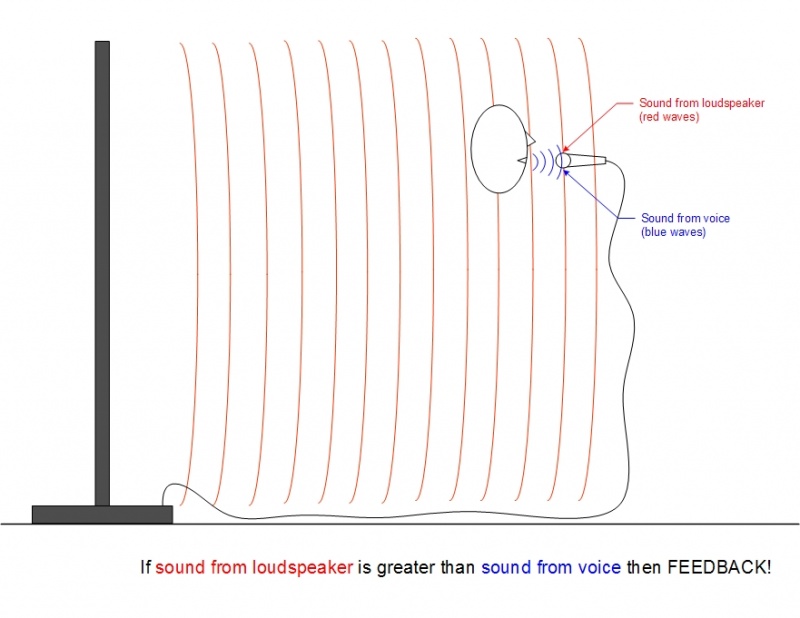Difference between revisions of "Microphone Sensitivity and Feedback"
(Improving explanation for non-engineers) |
m (image embedded in text, category added) |
||
| (3 intermediate revisions by the same user not shown) | |||
| Line 1: | Line 1: | ||
| − | {{Bose Reviewed}} | + | <noinclude>{{Bose Reviewed}}</noinclude> |
It is a common misconception that a microphone that has lower sensitivity (in other words, a sound of a given intensity at the microphone produces a lower electrical signal than a microphone of higher sensitivity) is somehow more susceptible to microphone feedback. | It is a common misconception that a microphone that has lower sensitivity (in other words, a sound of a given intensity at the microphone produces a lower electrical signal than a microphone of higher sensitivity) is somehow more susceptible to microphone feedback. | ||
| Line 5: | Line 5: | ||
Feedback occurs when the sound from the loudspeaker (or loudspeakers if a microphone is connected to more than one) is louder at the microphone than the sound of the voice. | Feedback occurs when the sound from the loudspeaker (or loudspeakers if a microphone is connected to more than one) is louder at the microphone than the sound of the voice. | ||
| + | <noinclude> | ||
| + | This fundamental fact is shown in the figure below. | ||
| + | [[Image:Feedback fig 1.jpg|800px|Microphone Feedback]] | ||
| + | |||
| + | </noinclude> | ||
If you just decrease the microphone sensitivity, the sound from the loudspeaker goes down by the amount of the sensitivity reduction. | If you just decrease the microphone sensitivity, the sound from the loudspeaker goes down by the amount of the sensitivity reduction. | ||
If you restore the level from the speaker by adding more gain at any trim or volume control, the difference between the level of the speaker at the microphone and from the voice is restored. | If you restore the level from the speaker by adding more gain at any trim or volume control, the difference between the level of the speaker at the microphone and from the voice is restored. | ||
| − | When the added gain exactly compensates for the reduced | + | When the added gain exactly compensates for the reduced microphone sensitivity we have the same difference as before. If the microphone fed back at a certain level in the room before, it will do so again at the same level in the room. This is obscured by the other variables that tend to change when we pick a microphone with a different sensitivity: different microphone frequency response and polar pattern details, different placement, etc. |
| + | |||
| + | The only way to get more gain before feedback is to lower the strength of the feedback path (the path between the speaker and microphone ) while the feed-forward path (the path from the voice to the microphone ) has the same gain. The microphone has to be in a quieter part of the sound system’s coverage or the microphone has to be directionally resistant to the speaker’s sound field compared to how well it picks up the desired input. | ||
| + | |||
| + | So it all comes down to one thing: when there is enough loudness in the room, how much better can the microphone hear the desired source than it hears the sound system? Sensitivity doesn't enter into this equation. | ||
| − | |||
| − | + | ---- | |
| + | [[Category:Feedback]] | ||
Latest revision as of 13:08, 16 April 2009
It is a common misconception that a microphone that has lower sensitivity (in other words, a sound of a given intensity at the microphone produces a lower electrical signal than a microphone of higher sensitivity) is somehow more susceptible to microphone feedback.
In the argument that follows, the assumption is that other variables in comparing two microphones are equal. In other words, only the sensitivity differs.
Feedback occurs when the sound from the loudspeaker (or loudspeakers if a microphone is connected to more than one) is louder at the microphone than the sound of the voice.
This fundamental fact is shown in the figure below.
If you just decrease the microphone sensitivity, the sound from the loudspeaker goes down by the amount of the sensitivity reduction.
If you restore the level from the speaker by adding more gain at any trim or volume control, the difference between the level of the speaker at the microphone and from the voice is restored.
When the added gain exactly compensates for the reduced microphone sensitivity we have the same difference as before. If the microphone fed back at a certain level in the room before, it will do so again at the same level in the room. This is obscured by the other variables that tend to change when we pick a microphone with a different sensitivity: different microphone frequency response and polar pattern details, different placement, etc.
The only way to get more gain before feedback is to lower the strength of the feedback path (the path between the speaker and microphone ) while the feed-forward path (the path from the voice to the microphone ) has the same gain. The microphone has to be in a quieter part of the sound system’s coverage or the microphone has to be directionally resistant to the speaker’s sound field compared to how well it picks up the desired input.
So it all comes down to one thing: when there is enough loudness in the room, how much better can the microphone hear the desired source than it hears the sound system? Sensitivity doesn't enter into this equation.
